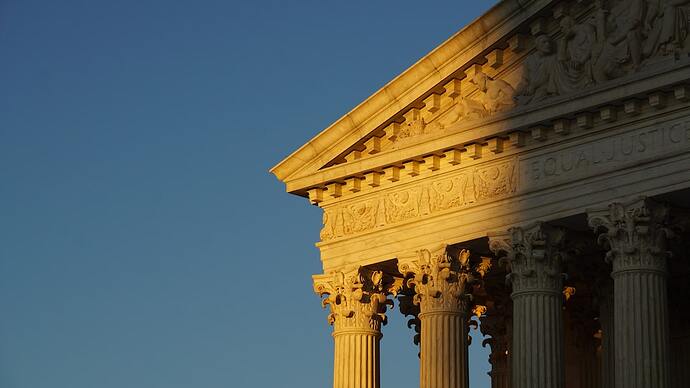The Supreme Court of the United States, commonly referred to as the Supreme Court or SCOTUS, is the highest court in the federal judiciary system of the United States of America. It is composed of nine justices, who are nominated by the President and confirmed by the Senate, and who serve on the Court for life or until retirement. The Supreme Court is responsible for interpreting the Constitution, resolving disputes between states, and overseeing the federal court system.
History
The Supreme Court was established in 1789, as part of the Judiciary Act, with a Chief Justice and five Associate Justices. The first Chief Justice was John Jay, who was appointed by President George Washington. The early Court dealt with a variety of issues, including disputes between states, admiralty and maritime law, and issues related to the federal government. The early Court was also instrumental in establishing the doctrine of judicial review, which grants the Court the power to declare acts of Congress and other government actions unconstitutional.
Over the course of its history, the Supreme Court has played a significant role in shaping American law and politics. The Court has been involved in some of the most important decisions in American history, including cases such as Marbury v. Madison (1803), which established the doctrine of judicial review; Dred Scott v. Sandford (1857), which denied citizenship to African Americans and fueled tensions leading up to the Civil War; Brown v. Board of Education (1954), which desegregated public schools; and Roe v. Wade (1973), which legalized abortion nationwide.
Structure and Jurisdiction
The Supreme Court is composed of a Chief Justice and eight Associate Justices. The Chief Justice is currently John Roberts, who was nominated by President George W. Bush and confirmed by the Senate in 2005. The Associate Justices are Ruth Bader Ginsburg, Stephen Breyer, Samuel Alito, Sonia Sotomayor, Elena Kagan, Neil Gorsuch, Brett Kavanaugh, and Amy Coney Barrett.
The Supreme Court has both original and appellate jurisdiction. Original jurisdiction means that the Court has the authority to hear cases for the first time, rather than reviewing decisions made by lower courts. The Court has original jurisdiction in cases involving disputes between states or cases involving foreign diplomats. Appellate jurisdiction means that the Court has the authority to review cases that have already been decided by lower courts. The vast majority of cases heard by the Supreme Court fall under appellate jurisdiction.
The Court typically hears cases that have significant legal or constitutional implications, or cases in which lower courts have issued conflicting rulings. Cases come before the Court through writs of certiorari, which are requests for the Court to review a lower court’s decision. The Court receives thousands of certiorari petitions each year, but only a small number are granted.
Decision Making
The Supreme Court typically meets from October to June each year, with breaks for holidays and winter recess. The Court hears oral arguments in cases during its October to April term. Each side is given 30 minutes to present its argument and answer questions from the justices.
After oral argument, the justices meet in conference to discuss the case and vote on a decision. In order for the Court to issue a decision, a majority of the justices must agree on the outcome and the reasoning behind it. Once a decision is reached, the Court issues a written opinion that explains the rationale for the decision and how it applies to the case at hand.
Supreme Court decisions are binding on all lower courts and have the force of law. They can only be overturned by the Court itself or by a constitutional amendment. As such, Supreme Court decisions have a significant impact on American law and society.
Criticism and Controversy
The Supreme Court has been the subject of criticism and controversy throughout its history. Critics argue that the Court is too powerful, that its decisions are often ideologically driven, and that its members are too insulated from public opinion. Others argue that the Court is too deferential to the political branches of government and that it has failed to adequately protect individual rights.
In recent years, the Court has been at the center of several controversial decisions, including Citizens United v. Federal Election Commission (2010), which removed limits on campaign spending by corporations and unions; Shelby County v. Holder (2013), which struck down key provisions of the Voting Rights Act of 1965; and Obergefell v. Hodges (2015), which legalized same-sex marriage nationwide.
Conclusion
The Supreme Court of the United States is a central institution in American law and politics. Its decisions have shaped the course of the nation’s history, and its justices have often been at the center of legal and political debates. The Court’s role in interpreting the Constitution and protecting individual rights will continue to be a major issue in American society and politics for years to come.
Disclaimer
6do Encyclopedia represents the inaugural AI-driven knowledge repository, and we cordially invite all community users to collaborate and contribute to the enhancement of its accuracy and completeness.
Should you identify any inaccuracies or discrepancies, we respectfully request that you promptly bring these to our attention. Furthermore, you are encouraged to engage in dialogue with the 6do AI chatbot for clarifications.
Please be advised that when utilizing the resources provided by 6do Encyclopedia, users must exercise due care and diligence with respect to the information contained therein. We expressly disclaim any and all legal liabilities arising from the use of such content.













